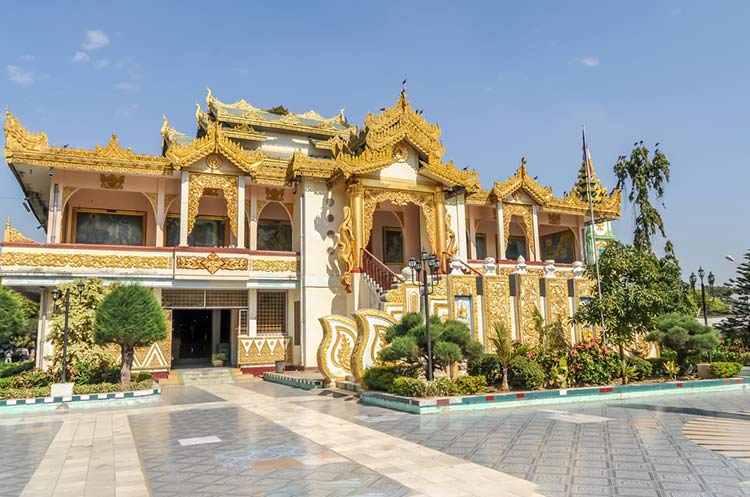
Temples & pagodas of Mandalay
Burma’s cultural and Buddhist center
Mandalay, a large city in central Burma was the capital of Burma for most of the second half of the 19th century. Now Burma’s cultural and Buddhist center, the area is known for its great number of temples and pagodas. Around the city are the remains of the ancient Burmese capitals Amarapura, Sagaing and Innwa.
Famous temples, pagodas & Buddha images in Mandalay
Mandalay houses one of Burma’s most important pilgrimage sites, the Mahamuni pagoda. The pagoda enshrines the country’s most highly revered image of the Buddha, the Mahamuni image. The image measuring nearly 4 meters tall and weighing some 6½ tonnes is covered with a thick layer of gold leaves, applied to it by devotees. According to legend the Mahamuni is a lifelike image of the Buddha cast about 2,500 years ago by a King who was impressed by the teachings of the Buddha who visited Arakan in West Burma.
The Shwenandaw Monastery is a 19th century teak wooden building known for its exquisite wood carvings. Originally part of the Royal Palace and completely gilded, King Mindon used the building as his personal living quarters. After the King died it was moved out of the Palace grounds and converted into a monastery.
The Kuthodaw pagoda is known as the “world’s largest book”. On the grounds are 720 shrines each containing a marble slab inscribed with texts from the Tripitaka, the Buddhist teachings. A large gilded pagoda resembles the ancient Shwezigon pagoda in Bagan.
Quite similar is the Sandamuni pagoda on the foot of Mandalay Hill. In the center of the grounds is a large gilded stupa built in 1874 surrounded by 1774 shrines each containing a marble slab inscribed with texts from the Buddhist teachings. The pagoda enshrines the Sandamuni image, the largest iron Buddha image in Burma weighing nearly 41,000 pounds, cast at the start of the 19th century.
Ancient cities around Mandalay
Around Mandalay are the remains of several ancient cities, three of which were once capital of a Burmese Kingdom.
Temples & pagodas in Mingun
Mingun is located North of Mandalay on the West bank of the Irrawaddy river. Near the river banks is the attractive Hsinbyume pagoda, an all white structure topped with a golden spire, constructed early 19th century. The pagoda was built to represent Mount Meru, the mythological mountain that is the center of the universe in Hindu and Buddhist cosmology.
The Mingun pagoda, a massive unfinished structure was built by a Burmese King at the end of the 18th century. The King who had acquired a sacred Buddha tooth relic wanted the pagoda to be the largest ever built in the world to enshrine the relic. Two giant Chinthe, mythological animals resembling a lion, measuring 29 meter tall guard the temple. Several earthquakes have done considerable damage to the structure.
Temples & pagodas in Amarapura
Amarapura, a few kilometers South of Mandalay on the East bank of the Irrawaddy river, was the old capital of the Konbaung dynasty. The town houses several attractive temples and pagodas, including the Kyauktawgyi pagoda, a beautiful white structure with a golden sikhara, modelled after the ancient Ananda pagoda in Bagan.
Other temples and pagodas worth a visit include the Mahagandayon monastery where monks study the Buddhist teachings, the Pahtodawgyi pagoda which resembles a Bagan era temple and the 12th century Shwe Gu Gyi pagoda, a very ornate monastery with a large golden dome enshrining several Buddha images including a large reclining Buddha.
Temples & pagodas in Innwa
Innwa was the capital of several Kingdoms between the 14th and 19th century. It is located South West of Amarapura on the East bank of the river. The towns main attractions are the Maha Aung Mye Bonzan monastery, an early 19th century heavily ornamented all brick building and the 1830’s Bagaya Kyaung monastery, an all teak structure known for its intricate wood carvings, supported by nearly 300 huge teak stilts.
Temples & pagodas in Sagaing
Sagaing is located opposite Mandalay on the West bank of the Irrawaddy river. It was the capital of the Sagaing Kingdom in the 14th century. As the town is a center of Buddhist learning and meditation, the hills of Sagaing are dotted with pagodas and monasteries, including one of the largest stupas in Burma, the Kaungmudaw pagoda which was constructed in the first half of the 17th century. Much older is the early 14th century Soon U Ponya Shin pagoda.
Temples & pagodas in Mandalay
Temples & pagodas in Burma